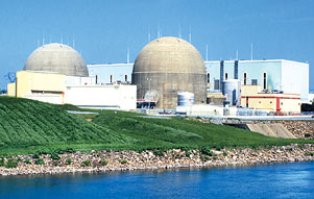Dominion has told the US nuclear regulator that, although the earthquake that struck near its North Anna facility in Virginia last month exceeded the plant's design basis, no significant damage has been found.
 |
| North Anna (Image: Dominion) |
Dominion has now informed the Nuclear Regulatory Commission (NRC) that "multiple detailed inspections have found no significant damage to equipment."
The company noted that North Anna, like other US nuclear plants, was hardened against earthquakes and other potential hazards in the 1990s. The company added that "an analysis at that time demonstrated that it could successfully withstand, without significant damage to safety systems, a quake much larger than the one recorded in central Virginia" on 23 August.
However, Dominion told the NRC that "seismic instruments showed that the quake caused accelerations at some frequencies greater than the station's design basis, but that no significant damage has been seen to any nuclear structures, equipment, pipes, valves, pumps, the Lake Anna dam or any safety-related equipment."
North Anna's licensing design basis is 0.12g (peak ground force acceleration) at 100 Hertz (Hz). However, Dominion notes that the plant's design accelerations are significantly higher than 0.12g in the critical range of 2 Hz to 10 Hz, where most earthquake damage is likely to occur. Instruments at the plant indicated that vertical and horizontal motion "very briefly" exceeded 0.12g in the 2Hz to 10 Hz range - by some 12% on average in horizontal direction and by about 21% on average in the vertical direction. The entire earthquake lasted for some 25 seconds, but the peak motion lasted only 3.1 seconds, Dominion said.
Eugene Grecheck, vice president of nuclear development at Dominion, said: "We are seeing exactly what independent seismic experts have told us to expect - minor damage such as insulation that was shaken off some pipes, electrical bushings that will be replaced and some surface cracking on non-seismic qualified walls."
He added, "Still, we will not restart the units until we have demonstrated to ourselves and the NRC that it is safe to do so. Based on results to date, we believe all tests and repairs will be completed on unit 1 by the latter part of September. Unit 2 is going into a planned refuelling outage and its restart will be based on that schedule."
The NRC noted that it had reviewed and evaluated recent US Geological Society earthquake hazard estimates for central and eastern US states that are used for building code applications outside the licensing of nuclear power plants. It stated, "These reviews showed that the seismic hazard estimates at some central and eastern US operating sites may be potentially higher that what was expected during design and previous evaluations, although there is adequate protection at all sites."
Researched and written
by World Nuclear News




_23621.jpg)

_63865.jpg)
_18570.jpg)





